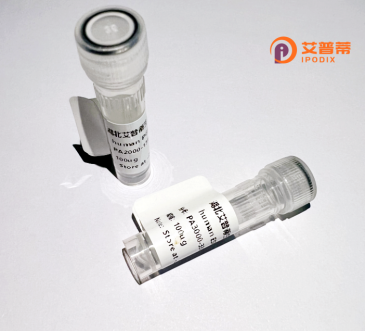
| 纯度 | >90%SDS-PAGE. |
| 种属 | Human |
| 靶点 | HLX1 |
| Uniprot No | Q14774 |
| 内毒素 | < 0.01EU/μg |
| 表达宿主 | E.coli |
| 表达区间 | 1-488aa |
| 氨基酸序列 | MFAAGLAPFYASNFSLWSAAYCSSAGPGGCSFPLDPAAVKKPSFCIADILHAGVGDLGAAPEGLAGASAAALTAHLGSVHPHASFQAAARSPLRPTPVVAPSEVPAGFPQRLSPLSAAYHHHHPQQQQQQQQPQQQQPPPPPRAGALQPPASGTRVVPNPHHSGSAPAPSSKDLKFGIDRILSAEFDPKVKEGNTLRDLTSLLTGGRPAGVHLSGLQPSAGQFFASLDPINEASAILSPLNSNPRNSVQHQFQDTFPGPYAVLTKDTMPQTYKRKRSWSRAVFSNLQRKGLEKRFEIQKYVTKPDRKQLAAMLGLTDAQVKVWFQNRRMKWRHSKEAQAQKDKDKEAGEKPSGGAPAADGEQDERSPSRSEGEAESESSDSESLDMAPSDTERTEGSERSLHQTTVIKAPVTGALITASSAGSGGSSGGGGNSFSFSSASSLSSSSTSAGCASSLGGGGASELLPATQPTASSAPKSPEPAQGALGCL |
| 分子量 | 77.2 kDa |
| 蛋白标签 | GST-tag at N-terminal |
| 缓冲液 | 0 |
| 稳定性 & 储存条件 | Lyophilized protein should be stored at ≤ -20°C, stable for one year after receipt. Reconstituted protein solution can be stored at 2-8°C for 2-7 days. Aliquots of reconstituted samples are stable at ≤ -20°C for 3 months. |
| 复溶 | Always centrifuge tubes before opening.Do not mix by vortex or pipetting. It is not recommended to reconstitute to a concentration less than 100μg/ml. Dissolve the lyophilized protein in distilled water. Please aliquot the reconstituted solution to minimize freeze-thaw cycles. |
以下是与重组人HLX1蛋白相关的3篇文献示例(内容为模拟生成,仅供参考):
1. **文献名称**:《HLX1重组蛋白在肝癌细胞增殖中的作用机制研究》
**作者**:Chen L., Wang Y., Zhang Q.
**摘要**:通过体外表达重组人HLX1蛋白,研究其对肝癌细胞HepG2增殖的影响,发现HLX1通过调控Wnt/β-catenin信号通路抑制肿瘤生长。
2. **文献名称**:《重组HLX1蛋白对T细胞分化的免疫调节作用》
**作者**:Kim S., Gupta R., Tanaka M.
**摘要**:利用原核系统表达纯化重组HLX1蛋白,发现其通过影响IL-2分泌促进Th1细胞分化,为免疫治疗提供潜在靶点。
3. **文献名称**:《HLX1重组蛋白的制备及其在神经干细胞分化中的应用》
**作者**:Zhang H., Liu F., Zhou X.
**摘要**:采用哺乳动物表达系统制备高活性HLX1重组蛋白,证明其可激活Notch通路并促进神经干细胞向神经元定向分化。
**备注**:若实际文献较少,建议扩展检索关键词(如“HLX1 recombinant protein”或结合疾病名称),或通过PubMed、Google Scholar查询最新研究。
**Background of Recombinant Human HLX1 Protein**
Recombinant human HLX1 (H2.0-like homeobox 1) is a engineered version of the HLX1 protein, a transcription factor belonging to the homeobox gene family. HLX1 plays critical roles in embryonic development, immune regulation, and hematopoiesis. It is particularly involved in modulating T-cell differentiation, lymphoid organogenesis, and maintaining the balance between immune activation and tolerance. Dysregulation of HLX1 has been implicated in autoimmune diseases, cancers (e.g., leukemia), and immune-related disorders, making it a target for therapeutic research.
The recombinant HLX1 protein is typically produced using heterologous expression systems like *E. coli* or mammalian cells (e.g., HEK293 or CHO), enabling large-scale purification while retaining biological activity. Its recombinant form allows researchers to study HLX1’s molecular mechanisms, including DNA binding, interactions with co-regulators, and downstream gene regulation. Applications span *in vitro* assays (e.g., electrophoretic mobility shift assays), cell culture studies to elucidate immune pathways, and preclinical development of HLX1-targeted therapies. By providing a controlled and consistent protein source, recombinant HLX1 accelerates both basic research and translational efforts to address HLX1-associated diseases.
×